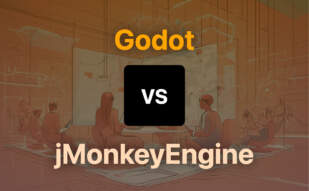jMonkeyEngine is an open-source 3D game engine for Java programmers, offering a code-first approach and minimalistic design. Known for its robust features like 3D audio support, advanced particle capabilities, and terrain libraries, jMonkeyEngine is favored by developers for its versatility and ease of use.

For those exploring alternatives to jMonkeyEngine, various options are available including Unity, Godot, LibGDX, Unreal Engine, Love2D, Heaps, Stride, RPG Maker, Babylon.js, GameSalad, Three.js, Phaser, Roblox, and SpriteKit.
Unity

Launched in 2005, Unity has fortified its place as a powerful game development engine, allowing developers to create both 3D and 2D games and applications, ranging from Augmented Reality to 3D simulations.
Unity Top Features
- Cross-platform: Enables launch of games across multiple platforms including Android and iOS.
- Adaptable: Compliant with numerous operating systems, which facilitates diverse application creation.
- Inclusive Development Suite: Offers a wide array of tools and features that assist in high-quality game creation.
- Asset Store: Furnishes developers with an assortment of pre-designed textures and features.
- Multiple Coding Languages: Supports BOO script, Javascript, and C# programming.
- Active Developer Community: Facilitates effective problem-solving, assistance, and feedback indications from users.
| Features | Benefits |
|---|---|
| Continuous Evolution | Improves user-friendliness, compatibility, and immersive visual experiences. |
| Learning and Collaboration | Encourages constant learning of new industry solutions and collective problem-solving. |
| AR/VR Focus | Inspires creation of mobile games and games with AR/VR capabilities. |
Unity Downsides
- New pricing model prompts per-install fees, leading to concerns among developers, especially solo and indie ones.
- Sudden unannounced changes have been detrimental to Unity’s trust relationship with its users.
- Developers fear these unexpected pricing shifts could compromise their financial sustainability.
Unity Pricing
Post-January 1st, 2024, developers will pay a fee each time a game using Unity software is installed or sold. However, Unity assures users that developers will not be charged an install fee until their game generates $200,000 in revenue and over 200,000 installations. Fees differ based on the geographical market, with “standard” markets like the US and the UK being charged higher than “emerging” markets like India and China.
Unity Use Cases
Use case 1: Game Development
Unity supports the creation of both 2D and 3D games, making it a suitable choice for developers focusing in either category.
Use case 2: AR/VR Development
Unity actively inspires the creation of Augmented Reality and Virtual Reality (AR/VR) applications, making it a viable solution for such innovative ventures.
Use case 3: Cross-Platform Projects
Developers seeking to design games or applications compatible across various platforms, including Android and iOS, can greatly benefit from Unity’s versatile cross-platform capability.
Godot
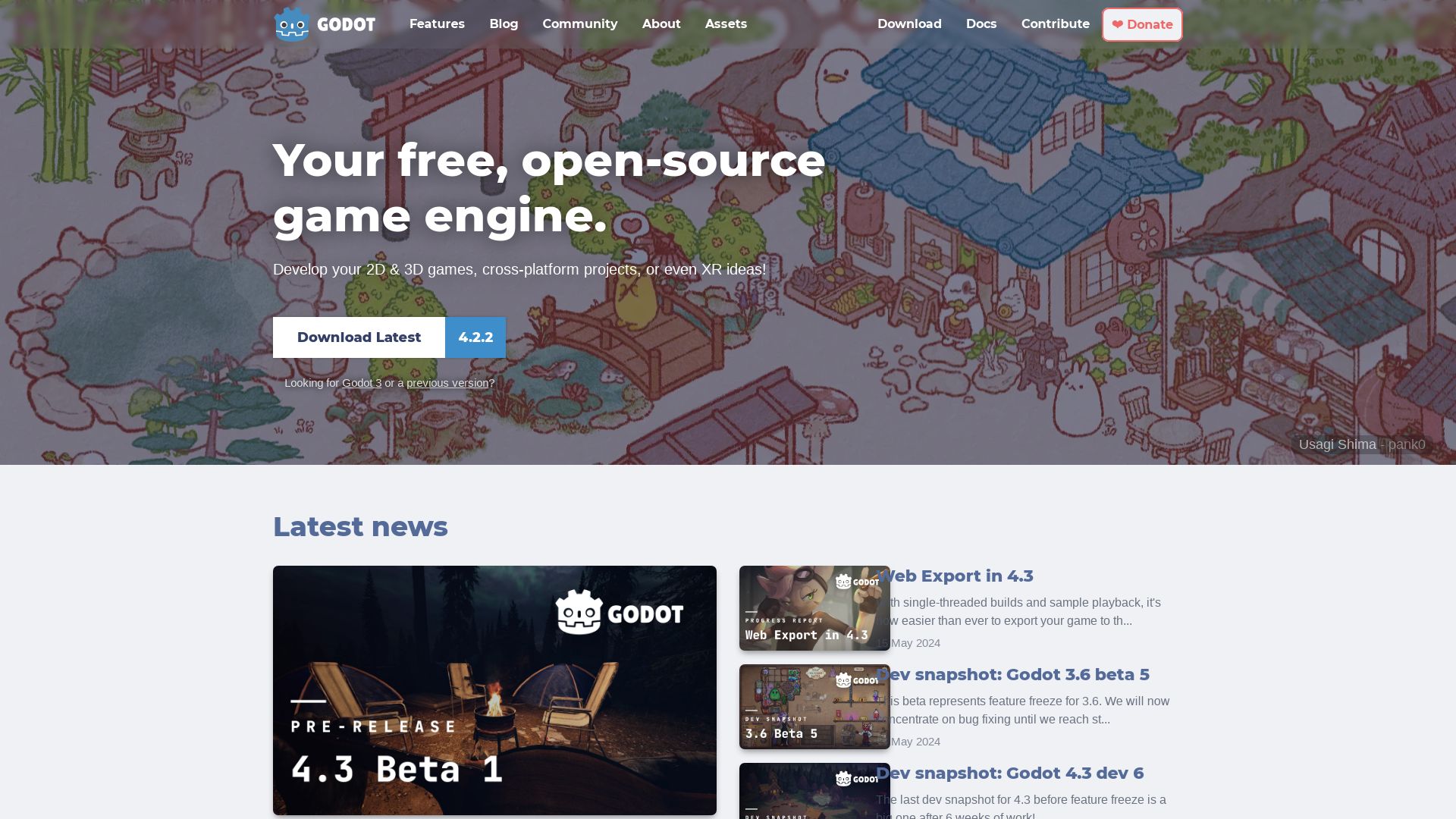
If you are seeking an open-source game engine with an intuitive design, Godot deserves your attention. It operates on an innovative scene-driven structure that enables both simple and complex game creation.
Godot Top Features
- Scene-driven design: Godot uses blocks to construct game scenes, allowing complex and reusable components, with each scene being a combination of one or more nodes. These nodes create the game’s smallest building blocks, and nodes can further communicate using signals.
- Scripting languages: Godot supports multiple scripting languages including GDScript, C#, and C++, while additional languages like Rust, Nim, Python are available through community support.
- Belnding and 2D workflows: Godot supports direct import of Blender files and offers a specialized 2D workflow for games and apps.
- Cross-platform functionality: Godot works on multiple platforms including Windows, macOS, Linux, and supports many mobile and web platforms.
| Features | Description |
|---|---|
| Built-in Scripting Language | GDScript is a high-performance scripting language native to Godot, taking the best from Python’s usability and a syntax optimized for game writing. |
| Integrated tools | Godot includes tools for scripting, editing, along with profilers and debugging tools. Suitable for both beginners and experienced game developers. |
| Regular updates | Godot is updated and improved regularly, providing the most up-to-date tools and functionality for game development. |
Godot Limitations
- Godot is not considered suitable for complex 3D game development.
- Support for the .NET platform is only available for desktop platforms in Godot 4.
Godot Pricing
One of the main draws of Godot is its open-source nature and user-owned games. This game engine is free under the MIT license with no licensing fees, contracts, or hidden costs.
Godot Use Cases
Use case 1: Indie Game Developers
With its intuitive design and diverse language support, Godot is ideal for Indie game developers. The engine’s ability to construct games out of simple blocks using nodes and scenes provides the flexibility and customization desired by many indie devs.
Use case 2: Educational Use
For educational institutions, Godot’s open-source nature is key. Students can learn essential coding skills in a real-life environment. Godot’s visual editor is a bonus, as it simplifies coding and makes it more accessible to beginners.
Use case 3: Small Game Studios
For smaller game studios, Godot’s cost-effectiveness and cross-platform deployment can help save resources. With the ability to export games to multiple devices, it caters to varying user preferences and increases potential reach.
Three.js
Engineered by Mr.doob, also known as Ricardo Cabello, Three.js is a well-regarded JavaScript library that comfortably sits on the forefront of the Augmented Reality world. Its inception in 2010 marked a significant turn in cross-browser 3D animations creation, utilising the power of WebGL.
Three.js Top Features
- WebGL 2.0: Three.js started employing WebGL 2.0 as a default from version 118, which signaled a great leap in the quality and efficiency of animations.
- Virtual Reality Support: With WebXR, Three.js extends its prowess to both Augmented Reality and Virtual Reality.
- High-Level Libraries: Using libraries such as GLGE and Scene.js, Three.js eases the process of creating complex 3D animations.
| Feature | Description |
|---|---|
| Developer Resources | Three.js is backed by a community of over 1700 contributors on Github, making it one of the most reliable engines to work with. |
| Compatibility | Hosted on all browsers that support WebGL 1.0, it ensures wide browser compatibility. |
| Material and Shaders | With substantial inputs from active contributors, its materials, shaders, and post-processing features have seen significant improvements. |
Three.js Downsides
As comprehensive as Three.js may be, it still grapples with some limitations:
- Complexity: For novices, getting hands-on with a vast and complex API like Three.js can be challenging.
- Lacks native mobile support: Mobile platforms might encounter performance constraints owing to the heavy WebGL use.
Three.js Pricing
True to the spirit of open-source software, Three.js is free to use, licensed under MIT.
Three.js Use Cases
Use case 1 – Augmented Reality Development
Three.js supports WebXR, making it an ideal choice for AR developers looking for a robust JavaScript library.
Use case 2 – 3D Interactive Websites
Web developers aiming to create innovative and interactive websites can leverage Three.js for stunning 3D visual effects and animations.
Use case 3 – VR Gaming
Given its ability to run GPU-accelerated 3D animations directly in the browser, Three.js stands as a reliable choice for developing browser-based VR games.
Phaser
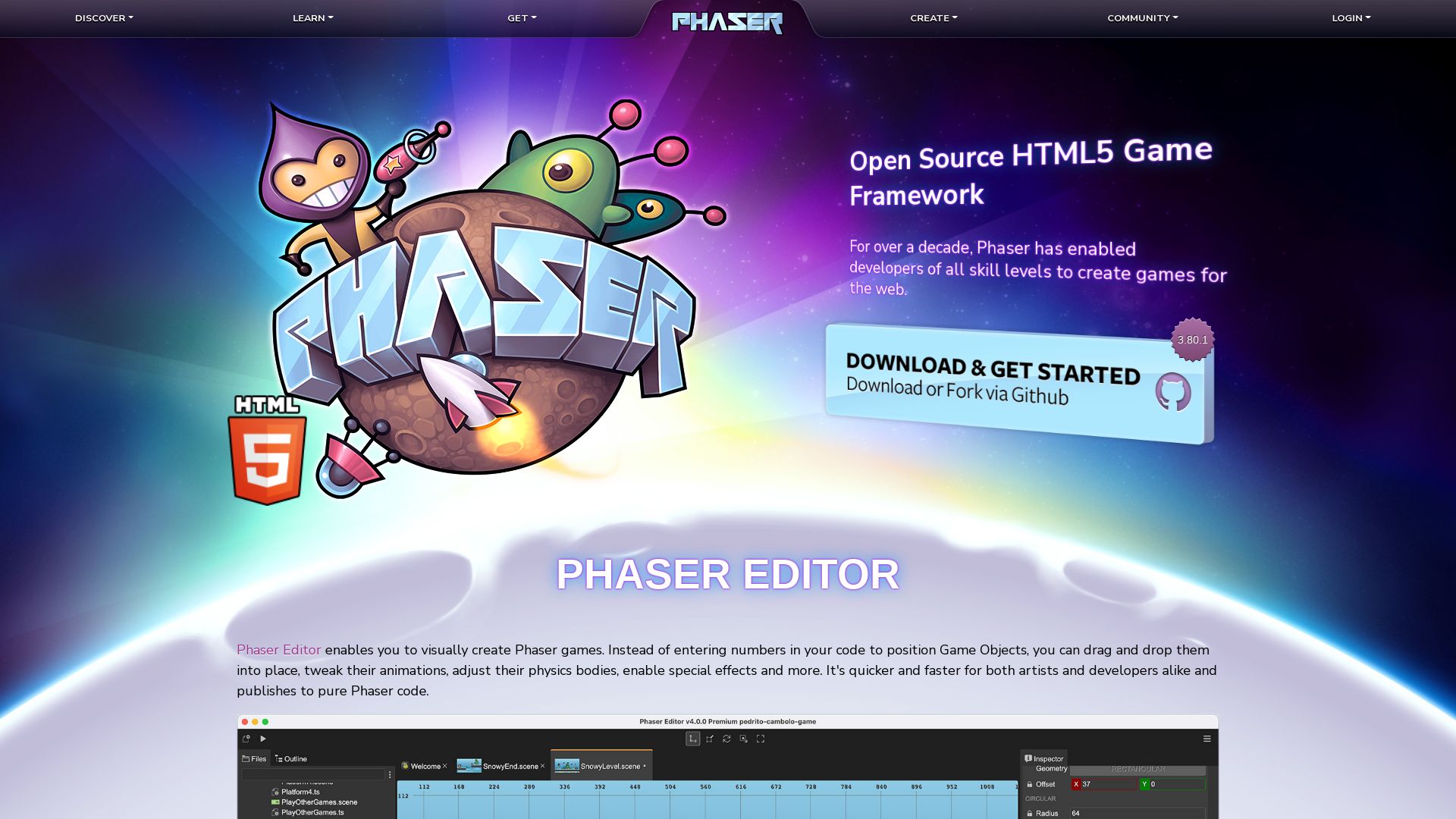
Phaser is a robust 2D game framework established in April 2013 by Richard Davey, dedicating itself to the creation of HTML5 games supported across desktops and mobile devices.
Based in JavaScript and TypeScript, it notably deploys games to iOS, Android, and native desktop applications, proving its adaptability and broad applicability.
Phaser Top Features
- Phaser encompasses a variety of versions including 1, 2.6.2, CE (Community Edition), and 3, with version 4 currently in development. These versions are regularly updated with community input on GitHub.
- It allows seamless rendering of graphics by employing WebGL renderer and Canvas, thereby providing quick transitions, amplified by browser support.
- Phaser gives you power and flexibility with the use of its multiple physics systems, namely Arcade Physics, Ninja Physics, and P2.JS.
| Characteristic | Description |
|---|---|
| File Structure | Consists of Scripts/js folders for game code and framework files, src folder for storing source files, assets folder for graphic and sound assets and finally an index.html file for initiating the game. |
| Sound Playback | Utilizes web and HTML5 audio for comprehensive sound design throughout the gameplay. |
| Learning Resources | Phaser provides over 1800 examples for budding game developers as well as active community support, and Phaser Mini-Degree by Zenva Academy deemed suitable for beginners. |
| Game Creation | Phaser.Game() initiates new game creation, while various functions such as create, add scene and preload() are present for asset and game element generation. |
Phaser Limitations
- Phaser is specifically designed for 2D games, which might limit its appeal to developers looking to work on 3D projects.
- The use of WebGL and Canvas for rendering may lead to compatibility issues with older browser versions that do not support these technologies.
Phaser Pricing
Phaser is an open-source game development engine, allowing developers to access it for free.
Phaser Use Cases
Use case 1
Phaser is a strong contender for beginners who are looking to jumpstart their journey into game development because of its comprehensive learning resources.
Use case 2
Platforms like Android Games and Facebook Instant Games can benefit hugely from Phaser due to its flexible usage and deployment capabilities.
Use case 3
For those keen on 2D game development, Phaser provides a perfect ground to get started with 1800+ examples and a strong, active community for support.
Roblox

Established in 2006 by founders David Baszucki and Erik Cassel, Roblox is a mammoth online gaming and development platform. Equipped with its own engine called Roblox Studio, the platform boasts an astonishing 50 million user-generated games, engaging over 100 million monthly active users.
Roblox Best Features
- Unparalleled User-Generated Content: With over 50 million games, Roblox offers a vast canvas for creativity and a widespread audience for game developers.
- Proprietary Engine – Roblox Studio: Enables users to code their games in Luau, a derivative of Lua.
- Robust Social Interaction: Roblox allows friends to connect, chat and play together, fostering a sense of community.
- External Software Compatibility: The platform works in conjunction with software like Blender for animated modelling, enriching the overall game-creating experience.
- Online Safety: Roblox employs algorithms to screen out sensitive personal data and inappropriate content, ensuring a secure player journey.
- Monetary Incentive: Rewarding game creators with payouts (over $100M estimated in 2019), fueling motivation and competition among developers.
| Feature | Description |
|---|---|
| Collaborative Development | Allows users to work on game development as a team, promoting cooperative learning and innovation. |
| User Acquisition | Largely organic growth via friend referrals or YouTube influences, ensuring a loyal and engaged user base. |
| Teaching Resources | Offers resources such as programming languages, game development basics, and online classes for learning game development. |
Roblox Downsides
- Moderation issues: Despite measures, Roblox has faced criticism for failing to adequately moderate user-generated content.
- Microtransactions: The platform uses the virtual currency, Robux, for in-game purchases, which can lead to unanticipated spending.
- Controversial User Content: Roblox has come under scrutiny for inappropriate content and misuse by adult players despite the platform’s ‘For Parents’ safety measures.
Roblox Use Cases
Use case 1
Roblox is an excellent platform for budding game developers
Use case 2
It also serves as an entertaining platform for gaming enthusiasts who delight in exploring millions of unique, user-generated games.
Use case 3
Beyond individuals, small businesses and freelance developers can leverage Roblox as a financially rewarding avenue to produce and monetise their game creations.
SpriteKit
![]()
An imaginative synergy of technology, physics and graphics, SpriteKit is a potent game development platform principally designed for the realms of iOS and macOS.
SpriteKit Top Features
- Offers a user-friendly interface for creating and animating 2D games.
- Exclusively architected over the SceneKit framework, enabling robust development capabilities.
- Employs the Box2D physics engine for life-like object interactions.
- Equipped with cross-platform game creation support via Game Center and iCloud.
- Supports and enhances Swift language for game development, optimizing code efficiency.
- Grants features like scene editing, animation, physics and particle systems for a versatile game creation experience.
| Components | Scene, Node, Sprite, Action |
| For Better Performance | Utilize circular shape |
| For Collision Accuracy | Employ alpha mask |
SpriteKit Limitations
- Development is restricted to the Apple ecosystem.
- The learning curve may steepen in the absence of expertise in Swift and iOS development.
- Shifting to the left in game development might demand more efforts.
SpriteKit Use Cases
Use case 1: 2D Game Development
With its user-friendly interface and animation capacities, SpriteKit proves beneficial for hobbyists and professionals alike venturing into the realm of 2D game development on iOS and macOS platforms.
Use case 2: Cross-platform Game Creation
SpriteKit comes with a built-in support for cross-platform game creation through iCloud and Game Center, making it tangible for developers eyeing extensive player reach.
Use case 3: Swift Language Utilization
For developers adept in Swift language, SpriteKit presents an opportunity to leverage their skills in creating fascinating, efficient gaming experiences.
LibGDX
If one is to navigate the grand theatre of game development, they might encounter the stalwart figure of LibGDX. This reliable Java game development framework has stood tall and unyielding for over 10 years, providing a canvas where creatives can harness the power of the Java ecosystem to bring their digital dreams to life.
LibGDX Top Features
- Unified API for seamless cross-platform deployment, covering Windows, Linux, macOS, Android, iOS, and the Web.
- Rich OpenGL ES 2.0/3.0 rendering capabilities, sparking life into every pixel.
- Integral gesture detection support enables creation of intuitive and interactive user experiences.
- Powerful audio streaming features, allowing nuanced soundscapes to be woven.
- Comprehensive Input handling to fully realize the potential of player interactivity.
- Extensive third-party ecosystem, a flourishing testament to its storied existence.
| Additional Features | Significance |
|---|---|
| 2D & 3D physics | Empowers enhanced realism via Box2D for 2D and Bullet physics for 3D scenarios. |
| Networking support | Brings integration of TCP sockets, HTTP requests, and WebSocket support under one umbrella. |
| Project creation tool, Maven integration | Facilitates smooth onset and management of projects, bypassing extraneous groundwork. |
LibGDX Downsides
- Basic graphics may seem limiting for projects demanding high-end visual effects.
- Being code-centric, LibGDX requires a solid understanding of Java, potentially creating a steeper learning curve.
- Limited official support may lead to longer troubleshooting sessions.
LibGDX Pricing
Resonating with the spirit of open-source ethos, LibGDX is free-to-use, enabling all developers to probe its depths without the hindrance of financial investment.
LibGDX Use Cases
Casual Game development
With its array of features and compatibility across numerous platforms, LibGDX proves its mettle in facilitating the development and deployment of casual games across a wide demographic sphere.
Educational Software Development
Curating interactive experiences becomes a reality with LibGDX, allowing for the creation of educational software that can engage with learners on multiple platforms.
Indie Game Development
Being free-to-use, LibGDX offers a conducive environment for Indie developers to bring their creative visions to life without the burden of excessive monetary investment.
Unreal Engine
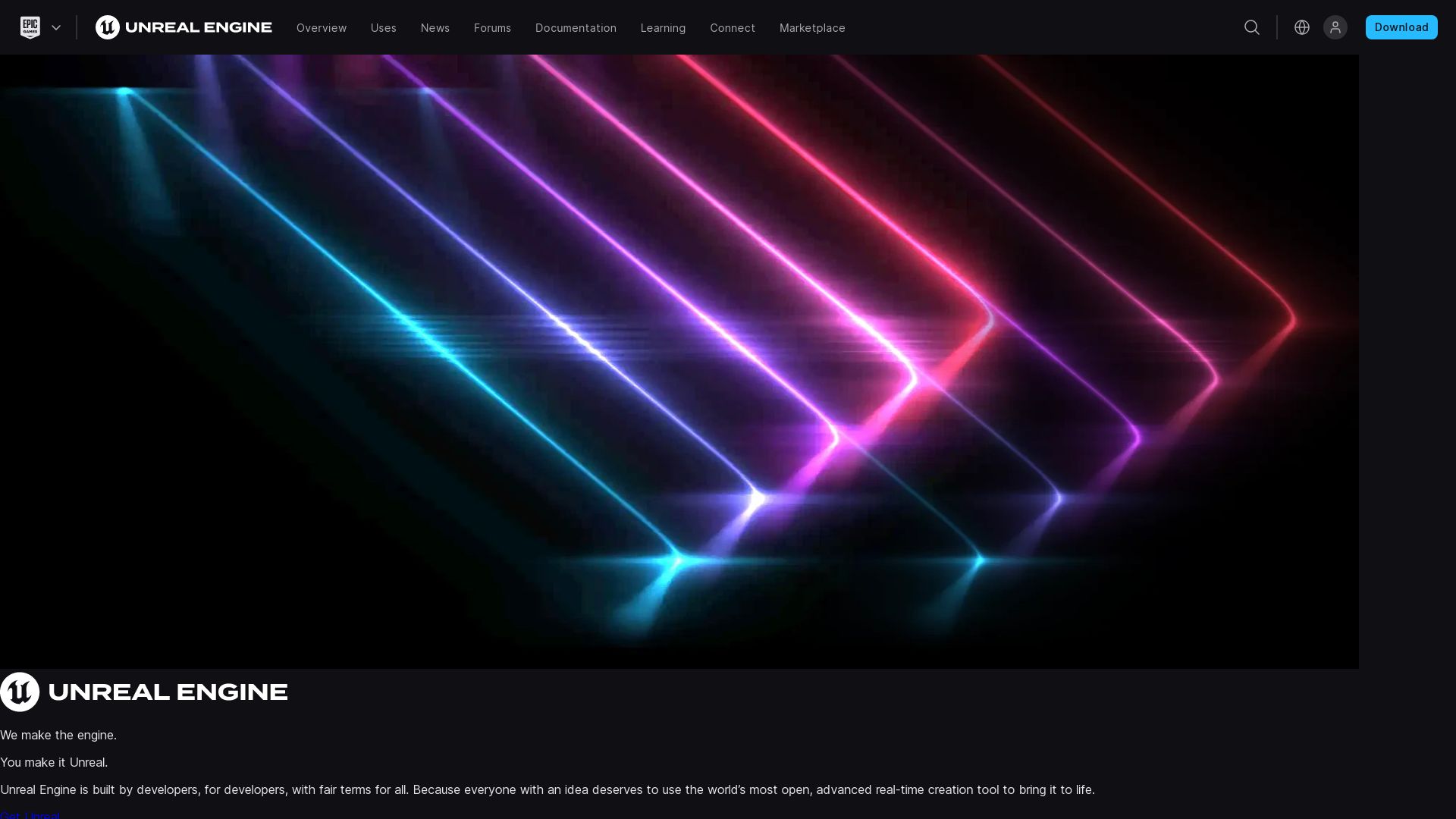
Developed by Epic Games, Unreal Engine redefines the gaming industry with its series of advanced 3D computer graphics game engines. Having transitioned across various game genres and industries including film and television since 1998, its versatility remains astounding.
Unreal Engine Top Features
- Wide Range Platform Support: Pulitzer winning feature of compatibility across desktop, mobile, console, and virtual reality platforms marks its unique cross-platform accessibility.
- UnrealEd Level Editor: The tool supports real-time constructive solid geometry operations giving developers an unmatched toolset.
- Revenue Friendly: Supports a generous revenue model, waiving royalties for games published on the Epic Games Store.
- Community Driven Marketplace: The Unreal Engine Marketplace offers a revenue-friendly model where creators get an appealing 88% share of revenue, empowering the developer community.
| Unreal Engine 5 | Launched in April 2022, it offers upgraded potential and features for game developers. |
| Educational Access | Unreal Engine is free for schools and universities, promoting educational adoption of their sophisticated technology. |
| Language Preference | Developers can utilize C++ for developing games within the tool, a popular and widely used programming language. |
Unreal Engine Downsides
- It might be a bit challenging for first-time game developers due to its comprehensive set of features and tools.
- The revenue model, advantageous for high earners, may deter small-scale developers or startups from choosing Unreal Engine.
Unreal Engine Pricing
Unreal Engine charges 5% of revenues over USD 1 million for commercial use. For products that make more than $3,000 per quarter, a 5% revenue charge applies. However, the engine is freely available for schools and universities.
Unreal Engine Use Cases
Use case 1 – Advanced Game Development
With advanced APIs and comprehensive toolset, Unreal Engine offers a compelling platform for developing high-end games, particularly in the first-person and third-person experiences.
Use case 2 – Virtual Reality Apps
Unreal Engine delivers an immersive VR experience making it a premium choice for creating virtual reality applications or games.
Use case 3 – Educational Institution Usage
Being free for schools and universities, Unreal Engine presents varied opportunities for students to learn and innovate in the vast landscape of game development and computer graphics.
Love2D
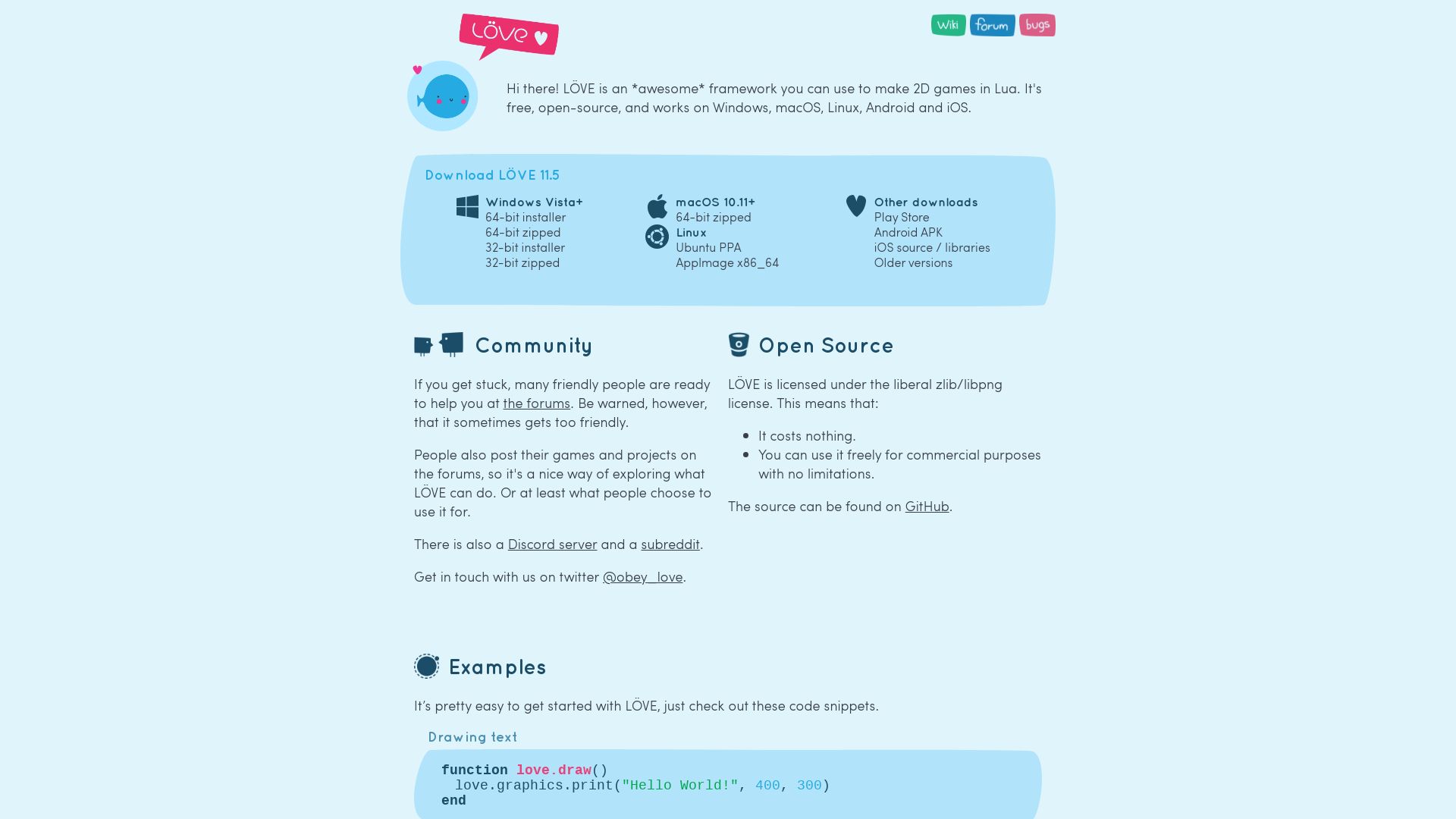
Introduced in 2008, Love2D is a free, open-source game framework primarily coded in C++. It uses the Lua scripting language and is compatible with multiple platforms including iOS, Android and browser counterparts.
Love2D Top Features
- Integrated with SDL and OpenGL libraries.
- Supports OpenGL ES 2 and 3.
- Incorporates physics engine Box2D and LuaSocket library for network features.
- Largely acknowledged in game development marathons like Ludum Dare.
- Presents FreeType engine for superior font rendering.
- Facilitates various audio, image formats, joystick controls, UTC-8 and OpenGL pixel shaders GLSL.
- Supports various forks, libraries and multiple implementations of Love, including LIKO-12, Lutro, ChaiLove.
- Ranking as the 10th most popular game development software on Itch.io, Love2D enjoys a market share of 1.97% as of July 2018.
| Key Feature | Description |
|---|---|
| Platform Support | Compatible with FreeBSD, OpenBSD, NetBSD, Windows, Linux, macOS, iOS, Android |
| Community Support | Active contribution via official Discord server, IRC channel, issue tracker and code patches. |
Love2D Limitations
- Primarily for 2D games. No support for 3D games.
- Though excellent in cross-platform support, it offers no guarantee of games working between different Love2D versions.
- Pales in power when compared to big leagues like Unreal, Unity.
- Presents limited modules and no graphical interface.
Love2D Pricing
As an open-source framework, Love2D is completely free for game development.
Love2D Use Cases
Use case 1: Rapid Game Prototyping
With easy installation, Lua code snippets, and an array of supported libraries, Love2D caters efficiently to rapid game prototyping.
Use case 2: Indie Game Development
Benefiting from a plethora of well-documented resources, Love2D has established itself as a credible choice for indie game developers.
Use case 3: Game Development Competitions
Love2D’s comprehensive features and its proven track record in competitions like Ludum Dare position it as an ideal tool for game development marathons.
Heaps

One of the stalwarts in the realm of gaming technology, Heaps, has earned its reputation as a high-performance, cross-platform graphics engine for creating versatile and powerful games.
Heaps Top Features
- Mature cross-platform graphics engine: Heaps is designed to deliver high-performance games across numerous platforms, effectively leveraging modern GPUs.
- Haxe Programming Language: As a brainchild of one of Haxe’s creators, Heaps utilizes the full potential of this popular programming language to develop complex game systems.
- Powerful Game Portfolio: Heaps is not just a tool, but a significant player in the gaming industry, featured in high-profile games such as Rushberry Mercs, Voidrun, Nuclear Blaze, and Evoland.
- Community Support: Heaps fosters a vibrant ecosystem of indie game developers, offering a network for sharing and learning content.
- 2D and 3D capabilities: Heaps supports both 2D and 3D development, catering to the needs of various game genres.
| Developed by Industry Veterans | Heaps is introduced by the creators of critically acclaimed games like Northgard and Dead Cells. |
| Replaces Flash | With the demise of Flash, Heaps serves as a viable choice, offering platform-independent benefits. |
| Performance Optimization | Regarded for its performance optimization and stability, Heaps clearly manifests its prowess in popular game titles like Dead Cells and Northgard. |
Heaps Limitations
- Scope of Functionality: Unlike full-featured game engines like Godot and Unity, Heaps is more of a library than a comprehensive game engine.
- Slower Integration: While Haxe-based game development has its benefits, the gradual integration of output into a codebase may take time.
- Learning Curve: The transition from other programming languages to Haxe might require an investment in time and effort.
Heaps Use Cases
Use case 1: Indie Game Development
With its vibrant community and the power of Haxe, Heaps is an advantageous choice for indie developers aiming to create high-performance and deeply engaging games.
Use case 2: Transitioning from Flash
For those seeking an alternative after Flash’s demise, Heaps stands as a compelling choice with its platform-independent benefits and robust performance.
Use case 3: Complex Game Systems
For developers aiming for deep narratives and multifaceted game systems, Heaps, with its potent combination of 2D and 3D capabilities, proves to be an advantageous choice.
Stride
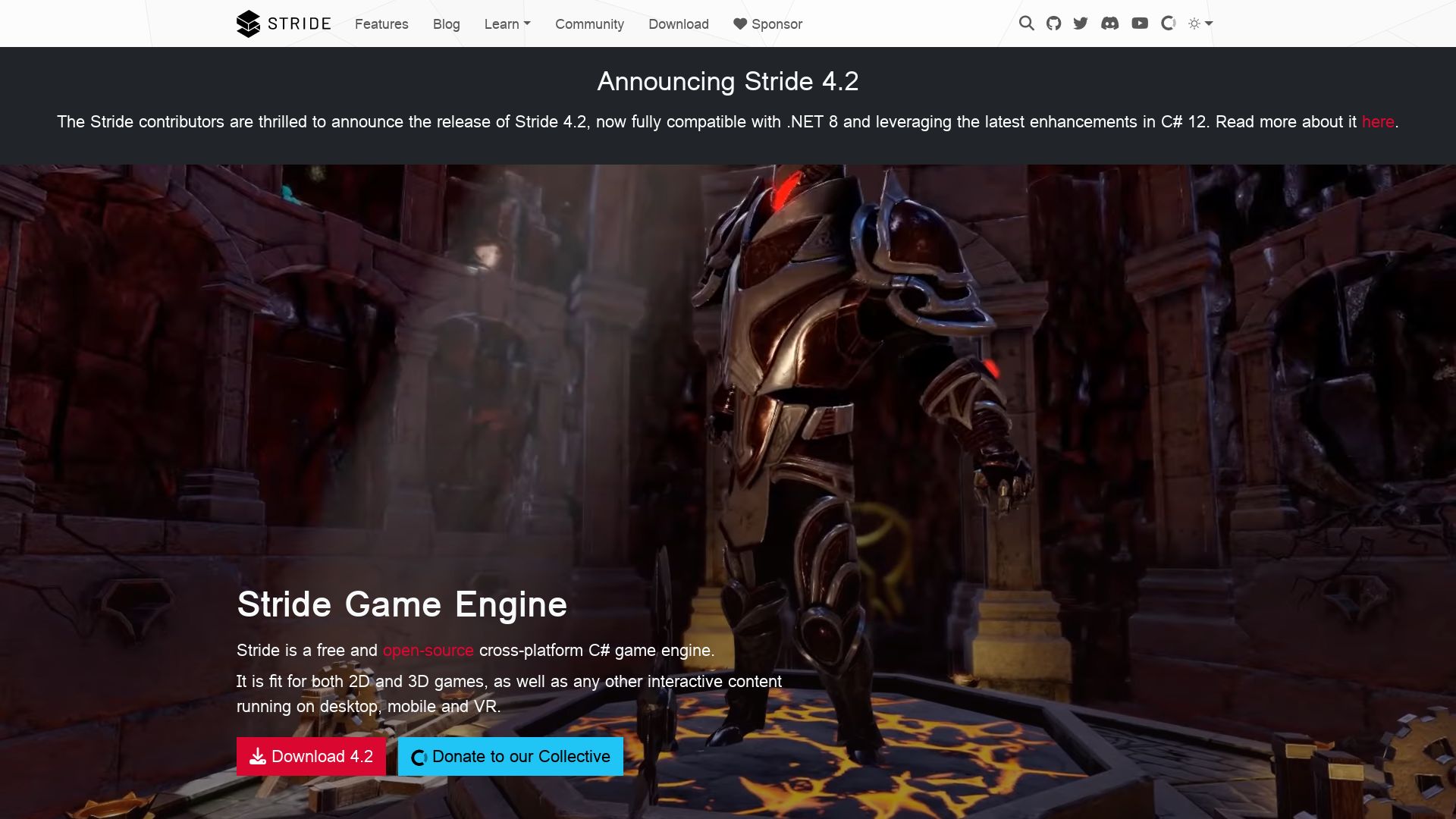
Originally known as Xenko, Stride is a free, open-source, cross-platform game engine, originating from the innovative minds at Silicon Studio. Its versatile applications span creating engaging video games for PC, mobile devices and even virtual reality platforms.
Stride Top Features
- C# Suite Tools: This facilitates developers in scripting game features for a more robust and customized gaming experience.
- Integrated Environment: Stride’s Game Studio provides an integrated environment for asset import, scene creation and arrangement using an entity component system.
- Customizable Shader System: It allows further customization of graphics, enhancing the visual appeal of the game.
- Sprite and Scripting Editors: These enable a detailed design of visual features and scripting for video games.
- UI Engine: Stride’s UI engine supports sophisticated user interface design.
| Feature | Description |
|---|---|
| PBR Layered Material Editor and Photorealistic Postprocess Effects | These elements can take the visual aesthetics of a video game to the next level, creating a more immersive user experience. |
| Scene Streaming System | This function enables seamless transition between game scenes, contributing to a smoother gameplay. |
| Cross-platform Runtime Support | Stride is compatible with a range of platforms, including iOS, Android, Windows UWP, Linux and PlayStation 4, broadening the availability of the game. |
Stride Limitations
- Lack of source code insights and limited documentation might make the learning process a little challenging for beginners.
- Since it is relatively new, Stride may not be as feature-rich as some of its older competitors.
Stride Pricing
As an open-source game engine, Stride is freely available for developers, fostering creativity and innovation without financial constraints.
Stride Use Cases
Use case 1: Independent Game Development
With a myriad of features available at no cost, it offers a tremendous platform for indie developers for crafting unique video games. Its cross-platform support ensures that games reach a wide audience.
Use case 2: Educational Use
Stride can serve as an impactful learning tool for computer science, digital arts, and game design students, allowing them to explore and learn the intricacies of game development.
Use case 3: Prototyping
For developers aiming to build a functional proof of concept or a game prototype, Stride can be a potent tool thanks to its flexibility and ease of use.
RPG Maker
Developed by ASCII, Enterbrain, Agetec, Degica, Gotcha Gotcha Games, RPG Maker is a game development engine primarily designed for creating story-driven RPGs. Since its initial release in December 17, 1992, it has evolved into a user-friendly, cross-platform tool that is written in JavaScript and HTML5.
Top Features of RPG Maker
- Simple to use: No coding knowledge is required making it beginner friendly.
- Robust character creation: RPG Maker offers comprehensive options for character design.
- Cross-platform: Games developed can run on a variety of platforms, including Windows, Mac, Xbox, Nintendo, Linux, PlayStation,and Gameboy.
- Vast community support: An extensive community of developers continuously contributing to modifications and improvements.
- Extensive DLC: Over 200 downloadable content packs are available to extend the flexibility and potential of your games.
| Feature | Description |
|---|---|
| JavaScript and HTML5 Written | Supporting a wide array of modern web standards and capabilities. |
| Plugin Implementation | Users can implement diverse, mostly free plugins to enhance game functionality. |
| Story-Driven Development | Allows for heavy emphasis on narrative and plot, leading to unique game mechanics and designs. |
RPG Maker Limitations
- Confined to engine’s capabilities, the game design is subject to certain limitations.
- Without a skilled developer, making a complex game could lead to its ultimate failure.
- Some games created with RPG Maker have sparked controversy, potentially affecting public perception.
RPG Maker Pricing
RPG Maker offers over 200 DLCs ranging $5-$25, enhancing the flexibility and capacity of your games.
RPG Maker Use Cases
Use Case 1: Beginner Developers
With an easy-to-use interface and low requirement for coding knowledge, RPG Maker is ideal for individuals embarking on their game development journey.
Use Case 2: Story-Driven Games
If your game idea revolves around a narrative or plot, RPG Maker allows for effective focus on such creative aspects, overcoming technical limitations.
Use Case 3: Cross Platform Development
For developers seeking to build games that can be run on various platforms, RPG Maker’s cross-platform flexibility makes it a suitable choice.
Babylon.js
Boy, oh boy. You’ll not want to miss the ‘Mona Lisa’ of 3D engines. Babylon.js, a side project developed by Microsoft employees, including the original maestro, David Catuhe, is fit for Picasso-level genius in the realm of virtual reality. The engine was first conceived in 2013 and has now reached a stable release with version 5.3.0.
Babylon.js Top Features
- Renders 3D models with triangular faceted polygon modeling—imagine origami, but on your computer!
- For those who like drawing within the lines, it offers constructive solid geometry for union, subtraction, and intersection of shell models.
- Produces photorealistic images thanks to physically based rendering and post-processing methods.
- ADA meets Arsène Lupin! It provides plug-in physics engines Cannon.js and Oimo for simulating real-world collisions and reactions.
- Animating characters through skeletons with blend weights will make you feel like the Picasso of the tech world.
| Language Written in | TypeScript, JavaScript |
| Repository | github.com/BabylonJS/Babylon.js |
| License | Apache License 2.0 |
Babylon.js Limitations
- HTML5 canvas element limiting impeccable rendering due to set pixel positions and colors by shader program.
- Limited use of constructive solid geometry. It’s like having a new car but only using it to go to the grocery store down the street.
Babylon.js Pricing
Hold your applause! Babylon.js is a blessing from the tech deity; it’s completely free and up for grabs. So why not get your hands dirty?
Babylon.js Use Cases
Use case 1
For Virtual Worlds: Fancy creating a wizarding world? Babylon.js puts the wand in your hands!
Use case 2
For Crime Data Visualization: Got Sherlock Holmes vibes? This engine will be your magnifying glass!
Use case 3
For Modeling Historic Sites: Time-traveling has never been simpler. Engineer the Pyramids or recreate Rome. The past is a click away!
GameSalad
Headquartered in Austin, Texas, GameSalad is a versatile, drag-and-drop game creation engine. It fosters simplified game development for platforms including iPhone, iPad, Android, and HTML5. Engagingly, it also promotes STEAM learning.
GameSalad Top Features
- Enables game testing on Apple devices and game publishing on the App Store.
- Comprises a complex behavior library for building sophisticated games.
- In-App Previewer allows real-time testing while the web publishing system provides for cross-platform publishing.
- Offers compatibility with Android, iOS, Windows, Amazon Marketplace, and includes a drag-and-drop coding platform.
| Pro Features | Education Involvement |
|---|---|
| GameSalad Pro introduces social features, monetization options, and offers discounts for distinct individuals such as students, educators, and US Military. | GameSalad has collaborated with educators at Connally High School, Texas, and James B. Conant High School, Illinois to promote game design education. |
GameSalad Downsides
- Limited to graphical UI for rules and behaviors: While this simplifies the process for beginners, it may limit the creative possibilities for advanced programmers.
- Staff reduction: GameSalad experienced a significant reduction of its staff between October-November 2012 which may affect the engine’s speed of future updates and improvements.
- Transition to paid membership: GameSalad discontinued free memberships in 2015, making it less accessible for those who are budget-conscious.
GameSalad Pricing
GameSalad shifted to a paid model in 2015. It does offer a special discounted price for students, educators, and US Military under the GameSalad Pro membership.
GameSalad Use Cases
Educational Use
GameSalad is widely used in over 223 schools for teaching computer science concepts, logical thinking, and problem-solving skills. It provides an engaging platform to explore CS principles through game development.
Indie Game Developers
With its user-friendly and intuitive drag-and-drop interface, GameSalad serves as a suitable choice for indie developers aiming to create games for iOS, Android, Windows, or Amazon Marketplace without comprehensive coding knowledge.
Instructors and Educational Institutes
Institutes and educators have an opportunity to leverage GameSalad’s curriculum-supporting features. The platform’s curriculum aligns with the ISTE standards, state CS standards, and K-12 CS Framework, enriching the educational experience.
Tiffany Brise
Content writer @ Aircada, patiently awaiting a consumer AR headset that doesn’t suck.




